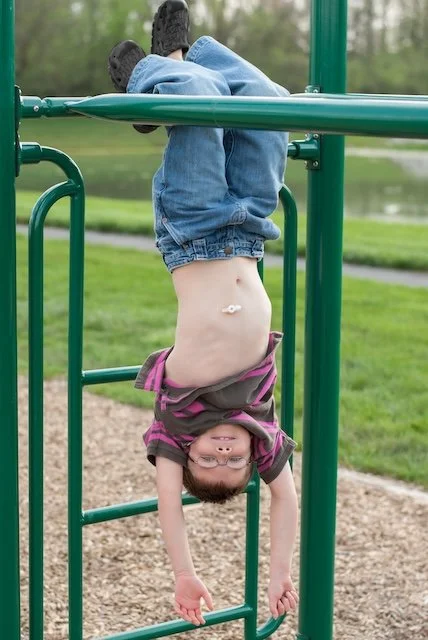Staying Active with a Feeding Tube: A Guide for Patients and Caregivers
-
How to Stay Active with a Feeding Tube: Living with a feeding tube doesn’t mean giving up physical activity. With the right guidance and support, movement can be safe, empowering, and beneficial. This guide covers:
Is it safe? Yes, with medical approval and proper precautions.
What activities work best? Walking, stretching, yoga, chair exercises, swimming (with clearance), dancing, and modified sports.
Can you play sports? Many low-impact sports are safe. Avoid high-contact activities unless cleared by your provider.
What about fitness classes? Start with low-impact options like yoga or barre. Let instructors know your needs and consider virtual classes.
How do you manage feeding around activity? Wait after bolus feeds before strenuous movement. Use a portable pump for continuous feeds and adjust based on how you feel.
How do you stay comfortable? Use tube belts or binders, wear supportive clothing, and protect the site from irritation.
Is this for all ages? Yes. the blog includes tips for children, teens, and adults.
What does Sentido Health offer? Enteral supplies, 24/7 support, insurance coordination, and our community hub, TubieTalk, on Instagram and Facebook.
Living with a feeding tube can bring many changes, but it does not mean giving up the things that bring you joy, like staying active. Whether you’re a parent supporting a child with a feeding tube, a caregiver, or someone navigating this journey yourself, physical activity can still be a meaningful, safe, and enjoyable part of life.
In this blog, we will walk through how to safely stay active with a feeding tube, including tips, activity ideas, and encouragement to help you or your loved one feel confident and supported.
Staying Active with a Feeding Tube Matters
Movement isn’t just about exercise; it’s about maintaining your strength, supporting digestion, boosting your mood, and improving your overall quality of life.
For those with feeding tubes, staying active can also help:
Prevent muscle loss and joint stiffness
Support healthy circulation
Promote independence and confidence
Reduce stress and improve mental well-being
Everybody is different, and “being active” can look like something as simple as stretching, walking to the mailbox, or dancing to music in your living room. What matters most is finding what feels good and sustainable for your individual needs.
Safety First: Talk to Your Healthcare Team
Before starting or adjusting any physical activity routine, always speak with your healthcare provider. Your doctor, dietitian, or home health team can help you determine safe practices for how to stay active with a feeding tube:
For example, they can help answer:
Which types of activities are safe
How to protect the tube and stoma site
If timing around feedings or medications is necessary
How to recognize signs of overexertion or complications
If your child has a feeding tube, their pediatrician or therapy team can also guide you on age-appropriate movement and developmental milestones.
Addressing Common Concerns
“Will the tube get in the way?” — Feeding tubes, whether they are nasogastric (NG), gastrostomy (G-tube), or jejunostomy (J-tube), can be safely managed during physical activity. With the right precautions, clothing, and awareness, movement is not only possible but encouraged.
“Is it okay to move after a feeding?” — In many cases, light activity such as walking is perfectly fine after a feeding and may even help with digestion. However, avoid strenuous or jostling movements right after feeding unless your care team says otherwise.
“What if the tube gets pulled out?” — Accidental dislodgement can happen, but it’s often preventable with a secure setup. Wearing supportive clothing or belts, taping down the tubing, and avoiding high-contact activities are great ways to reduce this risk.
Types of Safe and Supportive Activities
Everyone’s abilities are different, so the key is to start small and build gradually. Here are several types of activities that can often be done safely so you can stay active with a feeding tube.
Walking: One of the easiest and most accessible forms of activity. Whether it's a stroll around your home or outside on a paved path, walking supports circulation, mood, and energy.
Stretching and Yoga: Gentle stretching and yoga can increase flexibility, reduce tension, and help improve posture and breathing.
Chair Exercises: For those with limited mobility or during recovery, chair-based exercises can be a safe and effective way to stay moving.
Swimming (with provider approval): Swimming can be a great low-impact workout, but only if your tube site is fully healed and protected. Please note: Always get medical clearance. Read more about swimming with a feeding tube HERE.
Dancing or Music Play: Movement doesn’t need to be structured. Dancing around the house, playing movement games with children, or even light bouncing to music can lift spirits and get the body moving.
Playing Sports and Attending Fitness Classes with a Feeding Tube
Having a feeding tube doesn't mean you have to sit on the sidelines. Many people safely enjoy sports and fitness classes with a few precautions and the support of their care team.
Before You Begin
Talk to Your Doctor: Always get medical clearance before starting a sport or class to ensure it’s safe for your health and tube type.
Protect the Tube: Use abdominal binders, tube belts, or compression gear to keep the tube secure and minimize the risk of dislodgement.
Choose Low-Impact Options: Activities like walking, swimming (with a healed site), yoga, cycling, golf, Pilates, or tai chi are often safe and effective.
Modify as Needed: Adjust intensity, duration, or movements to match your comfort level. Take breaks and listen to your body.
Additional Tips
In Group Settings: Let instructors or coaches know about your tube and any accommodations you may need. Most are happy to support you.
Virtual Classes: Consider online or on-demand classes, which allow you to move at your own pace and modify as needed from home.
Use Caution: Avoid high-contact sports or intense movements that could strain or dislodge the tube unless cleared by your doctor.
With thoughtful planning and the right support, sports and fitness can be empowering ways to stay strong, confident, and connected.
Staying Comfortable While Active with a Feeding Tube
No matter which activity you choose, staying comfortable and protecting your tube is key. Here are some helpful tips to keep in mind.
Dress for support: Use specialized clothing, tube belts, or bodysuits that gently secure the tube in place and reduce friction.
Protect the site: Keep the stoma clean and dry. Use gauze or a barrier dressing to avoid irritation if needed.
Secure your setup: For continuous feeds, use a backpack designed for pump systems or a portable carrier that won’t disrupt movement.
Time your activity around feeding:
After bolus feeds, wait 30–60 minutes before strenuous activity.
Continuous feeds can often be done with a mobile pump in a backpack or waist pack.
Many people prefer to be active between feeds. Listen to your body and adjust as needed.
Avoid risky activities: High-impact sports or contact-heavy games can increase the risk of dislodging the tube. Choose gentler alternatives when possible.
Pay attention to how your body feels when staying active with a feeding tube and adjust your activity accordingly. Nausea, fatigue, or cramping are signs to pause and rest.
Encouragement for Different Life Stages
For Parents and Pediatric Patients:
Children with feeding tubes are still kids and they need time to play, move, and grow just like any other child.
Encourage age-appropriate play
Use onesies, tube covers, or wrap-around belts for infants and toddlers
Involve physical or occupational therapists for milestone support
For Teens and Young Adults:
Self-image and independence matter a lot during this phase. Support them by:
Encouraging sports or activities they enjoy (with precautions)
Validating their feelings about looking or feeling “different”
Connecting them with peers or support groups who understand
For Adults:
Whether you're newly adjusting or have had a feeding tube for years, it’s never too late to explore safe activities.
Walking, light weights, or tai chi are excellent low-impact choices
Group classes or virtual programs can provide social connection
Stay hydrated and protect against skin breakdown
Individuals with Feeding Tube Deserve to Thrive
Staying active with a feeding tube doesn’t just build strength in the body, it builds resilience in the mind. Many patients and caregivers report feeling more confident, empowered, and emotionally well when they move regularly.
If you or your loved one are feeling hesitant, overwhelmed, or unsure of where to start, remember:
You’re not alone.
Progress can be slow and that’s okay.
Every small step counts.
Having a feeding tube is just one part of your story. It doesn’t define your ability to move, grow, or enjoy life. With the right support, safety precautions, and mindset, staying active is not only possible, it’s powerful.
Enteral Supplies and Support with Sentido Health
At Sentido Health, we’re here to walk alongside you. We provide the products, education, and heartfelt support to help you or your loved one live life to the fullest.
Enteral Feeding Supplies and Formula
We offer a full range of enteral feeding supplies, including feeding tubes, backpacks, and a wide selection of nutritional formulas. Our team works directly with your insurance to provide these products at little to no cost, delivered straight to your door. We are available 24/7 with patient support and education, so you can feel confident in caring for your tube, whether you are a patient or a caregiver.
Join TubieTalk!
Connect with our online community, TubieTalk, on Instagram and Facebook. It is a space for support, education, and encouragement created for the tube feeding community. We share helpful tips, uplifting stories, and fun, relatable content.
Let Us Be Your Medical Supply Provider
To learn more about working with Sentido Health, call us at 713-955-2123 or submit a contact form HERE. We’ll reach out to guide you through the next steps.
*This content is for informational purposes only and is not a substitute for medical advice. Always consult your healthcare provider before making changes to your care or activity level*




